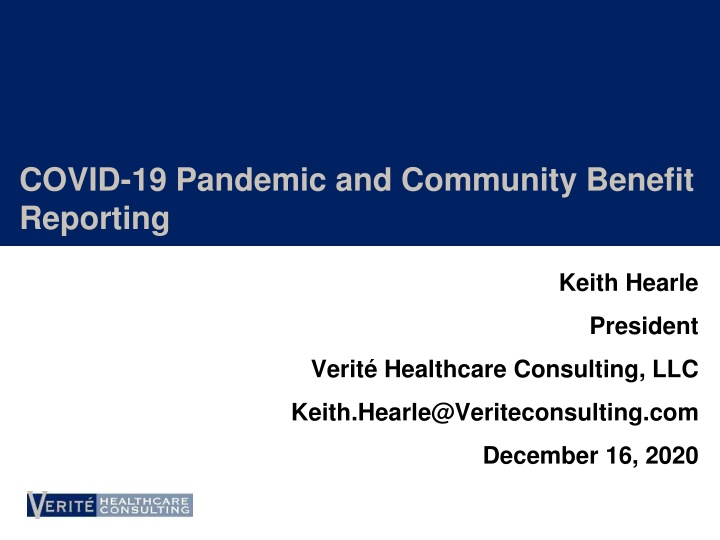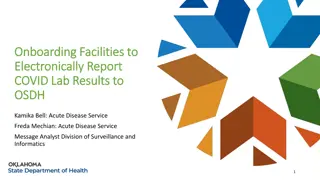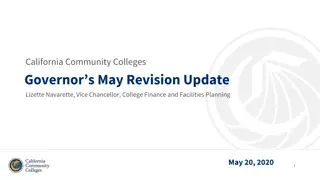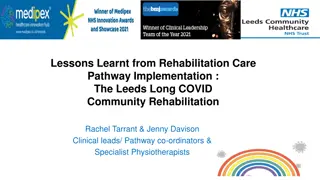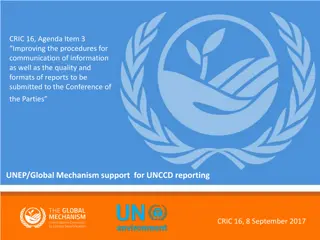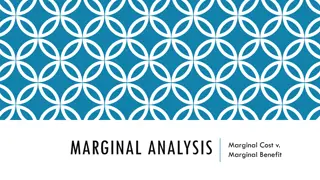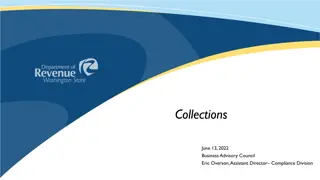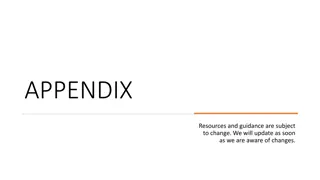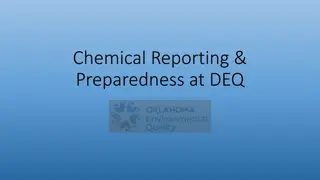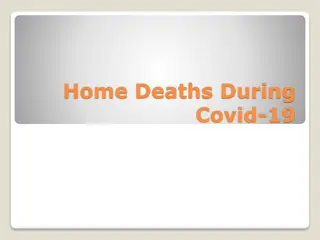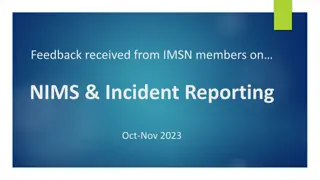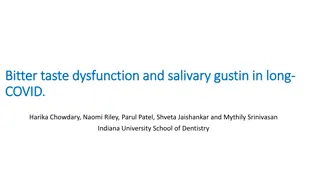Community Benefit Reporting Amid COVID-19
The COVID-19 pandemic is significantly impacting hospital finances. Learn about Provider Relief Funds and what counts as community benefit. Explore key questions and answers in this insightful report.
Download Presentation

Please find below an Image/Link to download the presentation.
The content on the website is provided AS IS for your information and personal use only. It may not be sold, licensed, or shared on other websites without obtaining consent from the author.If you encounter any issues during the download, it is possible that the publisher has removed the file from their server.
You are allowed to download the files provided on this website for personal or commercial use, subject to the condition that they are used lawfully. All files are the property of their respective owners.
The content on the website is provided AS IS for your information and personal use only. It may not be sold, licensed, or shared on other websites without obtaining consent from the author.
E N D
Presentation Transcript
COVID-19 Pandemic and Community Benefit Reporting Keith Hearle President Verit Healthcare Consulting, LLC Keith.Hearle@Veriteconsulting.com December 16, 2020
Outline Introduction Treatment of Provider Relief Funds COVID-19 activities and programs: what counts as community benefit Questions and answers Caveat: The information, recommendations, and guidance herein is preliminary and does not constitute tax or legal advice. 2
Introduction The COVID-19 pandemic is having dramatic impacts on hospital revenues and expenses Substantial Provider Relief Funds (PRF) and other assistance (PPP, FEMA CARES, state/local/tribal, ) have been appropriated to hospitals Instructions to IRS Form 990, Schedule H are silent on numerous, relevant issues (e.g., treatment of PRF funds) However, they still apply and answers to most if not all questions can be found there and in other, emerging guidance It s preferable to be conservative and grounded in underlying community benefit reporting principles 3
Treatment of Provider Relief Funds IRS Form 990 instructions state that direct offsetting revenue includes restricted grants used for community benefits The PRF funds are substantial: For some organizations, lost revenues are less than PRF allocations These organizations are identifying health care related expenses that are attributable to coronavirus But should these funds be considered restricted grants ? 4
Treatment of Provider Relief Funds Yes, PRF funding (probably) should be considered a restricted grant Providers must certify that the Payment will only be used to prevent, prepare for, and respond to coronavirus, and shall reimburse the Recipient only for health care related expenses or lost revenues that are attributable to coronavirus (Terms and Conditions) Use of PRF funds is subject to single audit and recoupment While not labeled by HHS as restricted grants, the PRF funds have many similar attributes [Stakeholders and policy makers may raise questions if PRF funds are paying for community benefits, but are being left out] 5
Treatment of Provider Relief Funds Suggested community benefit reporting principles: If a hospital has reported certain expenses as (A) community benefit and also in (B) expenses attributable to coronavirus, then a reasonable portion of PRF revenues should be included in direct offsetting revenue Note that PRF revenues are likely to be less than PRF payments given uncertainties around the ability to keep all of the funds Similarly, if a hospital has reported certain revenue losses as (A) community benefit and also in (B) lost revenues attributable to coronavirus then a reasonable portion of PRF revenues also should be included Schedule H instructions still apply There should be consistency between reports filed with the IRS and reports filed with HHS 6
Treatment of Provider Relief Funds 2020 operating expenses for hospitals probably include expenses attributable for coronavirus that have been (or will be) submitted to justify retention of PRF funds These expenses (which are covered by revenue) will be included in the ratio of patient care cost to charges unless adjustments are made Financial assistance, Medicaid, and other expenses thus will include expenses attributable to coronavirus for which PRF funds have been provided unless adjustments are made PRF funding thus affects several categories of community benefit: Categories that rely on the ratio of patient care cost to charges Subsidized Health Services that probably have experienced revenue losses that have been fully or partially reimbursed by PRF funds Community health improvement and other categories where expenses have or will be submitted to justify retention of PRF funds 7
Example Calculations Calculate a PRF Revenue Percentage for the year = PRF revenue (from financial statements) Revenue Losses + Expenses Attributable (per HHS report) Example: $45 million / ($43 million + $7 million) = 90% The percentage represents the proportion of expenses and lost revenues that have been covered by PRF revenue recognized by the hospital 8
Example Calculations COVID-19 related community health improvement program: Total community benefit expenses = $1,000,000 (included both in Schedule H and in HHS reports) Direct offsetting revenue (PRF revenue) = $900,000 (total expense x PRF Revenue Percentage) Net community benefit expenses = $100,000 Subsidized Health Service: Total expenses = $10,000,000 (excluding Medicaid ) Net patient revenue (excluding Medicaid, financial assistance, bad debt) = $7,000,000 (amount dropped by $1 million from 2019) PRF revenue for $1,000,000 revenue loss (2020 versus 2019) = $900,000 Net community benefit expenses = $2,100,000 9
Example Calculations Ratio of Patient Care Cost to Charges and Financial Assistance Unadjusted Option 1 Option 2 Comment Ratio of Patient Care Cost to Charges Charges 333,333,333 $ 333,333,333 $ 333,333,333 $ Adjusted Operating Expenses PRF Cost Recovery Adjustment Re-adjusted Operating Expenses 100,000,000 $ $ 100,000,000 $ 100,000,000 $ (6,300,000) $ 93,700,000 $ 100,000,000 $ $ 100,000,000 $ - - 90% of COVID Expenses Ratio 0.300 0.281 0.300 Note: Total COVID Expenses Note: COVID Expenses/Charges $ 7,000,000 $ 7,000,000 0.021 Claimed to HHS $7 million / $333.3 million Financial Assistance Charges Expenses PRF Revenue for COVID Expenses Net Expenses 10,000,000 $ 3,000,000 $ $ 3,000,000 $ 10,000,000 $ 2,811,000 $ $ 2,811,000 $ 10,000,000 $ 3,000,000 $ $ 2,811,000 $ - - 189,000 FA COVID Expenses x 90% Note: COVID Expenses $ 210,000 FA Expenses x 0.021 10
IRS: What Counts as Community Benefit? To count, a program or activity must respond to a demonstrated health/related community need and seek to achieve at least one community benefit objective: Improve Access to Health Services Enhance Public Health Advance Generalizable Knowledge Relief of a Government Burden to Improve Health 11
IRS: Characteristics of Community Benefit Activities and Programs Are available broadly to the public and serve low-income consumers. Reduce geographic, financial, or cultural barriers to accessing health services, and if they ceased would result in access problems. Address federal, state, or local public health priorities such as eliminating disparities in access or health status among different populations. Leverage or enhance public health department activities. Strengthen community health resilience by improving the ability of a community to withstand and recover from public health emergencies. Otherwise would become the responsibility of government or another tax- exempt organization. Advance increased general knowledge through education or research that benefits the public. 12
IRS: Programs that should not be counted Activities or programs may not be reported: if they are provided primarily for marketing purposes if the program is more beneficial to the organization than to the community; for instance, if the activity or program is designed primarily to increase referrals of patients with third-party coverage, required for licensure or accreditation, or restricted to individuals affiliated with the organization. Primary purpose: Organizational Benefit versus Community Benefit [Also don t generate expense to the organization] 13
Programs that should not be counted Note: expenses that aren t directly assigned to a community benefit service (e.g., community health improvement services) are included in the ratio of patient care cost to charges Portions of these expenses will be included in Financial Assistance, Medicaid, and wherever the ratio is used Costs incurred to be able to provide patient care for which the hospital bills, except for: Financial Assistance, Medicaid, Other Means Tested Government Programs, and qualifying Subsidized Health Services Not recommended, but organizations could adopt a rule that if expenses have been reported to HHS as attributable to coronavirus, they aren t reportable as community benefit 14
Financial Assistance: COVID-19 Considerations The HRSA COVID-19 Uninsured Program Financial Assistance Per CMS: hospitals that receive PRF payments from the Uninsured Program must not report charges reimbursed through that program for uninsured COVID-19 patients on Worksheet S-10 of the Medicare Cost Report Consider amending financial assistance (and billing and collections policies) during the pandemic Interim or permanent coverage for telemedicine Catastrophic coverage, presumptive eligibility Treatment of CARES Act financial support received by patients Implications for AGB discounts Extending payment plans, reducing or deferring ECAs Ability to re-apply for assistance with payment plan balances 15
Community Health Improvement Services: Reportable COVID-19 Activities and Programs Community health education designed to increase awareness of COVID-19 risks, available testing and treatment services, needed social services, how to access available community resources, how to stop the spread Free or nominal cost (non-billed) COVID-19 testing sites, flu shot clinics, telemedicine Operating or participating in the work of community disaster response (incident response) centers Hub for distribution of vaccines to unaffiliated community providers or vaccine sites Information and referral services (e.g., unbilled ask a nurse services) with information about community-wide resources Safe, outbound transportation services for patients in need 16 16
Community Health Improvement Services: Reportable COVID-19 Activities and Programs Support groups for COVID-19 patients Programs that address COVID-19 related food and housing insecurity Staffing and other expenses to enhance COVID-19 related disaster readiness and responsiveness Over and above licensure requirements, and/or Focused on community-wide readiness Operating or participating in the work of community disaster response (incident response) centers Coordinating activities and programs with public health agencies, other hospitals, other community agencies 17 17
Other Categories Community Benefit Operations Costs to update CHNAs and revise implementation strategies to incorporate pandemic concerns Health Professions Education COVID-19 related education if it counts towards licensure or certifications needed by health professionals to practice (e.g., CME that counts towards maintaining licenses) 18 18
Other Categories Subsidized Health Services Clinical programs that meet the definitions that apply to Subsidized Health Services after including a reasonable portion of PRF revenue for revenue losses and COVID- 19 expenses that have been (or will be) submitted to HHS It s possible to assess a COVID-19 Product Line; however, PRF revenue may well cover reportable losses 19 19
Other Categories Research COVID-19 related research studies if they ve been funded by a tax-exempt source (including the hospital itself), and the goal of which is to generate increased generalizable knowledge made available to the public Contributions For Community Benefit Cash contributions and grants to other organizations for COVID-19 related community benefits In-kind donations of PPE, supplies, staff time devoted to community-wide pandemic responses 20 20
Other Comments Like hospital financial statements, Schedule H and other community benefit reports are likely to show dramatic year-over-year changes It s important to discuss accounting/reporting methods (including the treatment of PRF funds) in Part VI of Schedule H Hospitals may want to prepare PR materials in advance, particularly if net community benefits as a percent of expense has fallen The field may want to get ahead of GAO/Congressional scrutiny of how PRF funds have been treated and any major changes in the numbers 21 21
